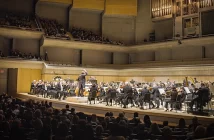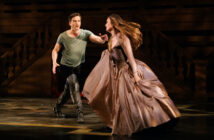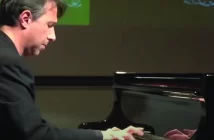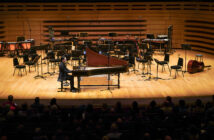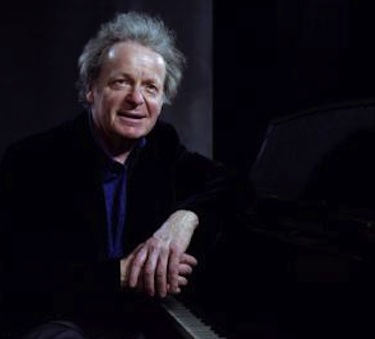
Anton Kuerti arrived in Canada in 1965, and Toronto has been his home base ever since. In that span of 45 years, this extraordinary artist has demonstrated time and again that he has no peer in the performance of the piano music of Beethoven, Schubert and Schumann.
In Canada, Kuerti is a national treasure; in the United States, he has had an illustrious career, stemming from his student days in Cleveland and Philadelphia, to his now regular concertizing in America’s major cities. Those fortunate enough to be in McCullough Hall at the University of Texas (Austin) last week, had the rare pleasure of hearing Kuerti in an all-Beethoven recital presented by Texas Performing Arts.
Masterful: Insight, Technique and Temperament
Kuerti’s Austin engagement included an inspiring master class with students from UT’s Butler School of Music. In works by Mozart, Clementi and Brahms, he encouraged those who performed for him to dig deeper, especially in matters of research and phrasing. He suggested various ways in which the meaning of the music can be realized through careful attention to accents and the placement of chords. On the question of how to play trills and other ornaments in early music, he made it clear that while extensive study of all the appropriate sources is absolutely essential, in the end the artist must use his intuition to solve these kinds of challenges.
His reputation having obviously preceded him, McCullough Hall was packed for Kuerti’s recital. He opened with the Sonata No. 26 in E flat major Op. 81a Les Adieux. The program notes – penned by Kuerti himself – suggested that we should not press the extra-musical allusions in this piece too hard: “…what really matters are not the events, but the universal emotions associated with them.”
Briefly, the sonata deals with the departure of Beethoven’s friend and benefactor (the Archduke Rudolph), on a long trip. The first movement depicts the farewell; the second the loneliness Beethoven felt during his friend’s absence; and the last, the Archduke’s joyous return.
From the opening bars, Kuerti captured the tenderness of the piece, as well as Beethoven’s obvious sincerity. Too often, in performances of Les Adieux, the slow music is too loud and lacking in repose and the fast music is trivialized. Not so on this occasion. In Kuerti’s hands, each note was imbued with feeling and nobility.
Incomparable Appassionata Brings Audience to its Feet!
For many listeners, the Sonata No. 23 in F minor Op. 57 Appassionata, is the greatest of all Beethoven’s works for piano. It has beauty, excitement and grandeur, and most of all, perhaps, the power that we associate with the mature Beethoven. It was all there, in Kuerti’s performance.
There is nothing quite like the opening bars of the Appassionata. The music starts pianissimo and continues at this volume for almost fourteen bars. Like most pianists, Kuerti ignored the allegro assai tempo marking in order to accentuate the mystery of this remarkable introduction. Then come the true Beethovenian outbursts, first in forte and then in a shattering fortissimo. Before long we arrive at the noble theme in A flat major, which is really a transformation of the mysterious passage in F minor which had opened the movement. Kuerti fully realized the intensity of the piece without sacrificing its architecture. A great performance!
Kuerti received a standing ovation for his performance of the Appassionata, but after several returns to the stage he cut off the applause with a wave of his hand. He suggested to audience members that before they left for intermission, they might like some helpful comments about the Diabelli Variations, the next work on the programme. Having said this, he launched into a brilliant twenty-minute analysis of this long and difficult work, illustrating – among other things – which elements of Diabelli’s waltz tune were used in which variation.Taking their seats after intermission, the capacity audience was primed and ready for the Diabelli.
Exposing Diabelli Variations as Indisputable Masterpiece
Kuerti’s tempo for the waltz theme was very moderate indeed. Compare, for example, another celebrated interpreter of this great work, Alfred Brendel. Brendel comes out of the gate at about double Kuerti’s tempo. Beethoven’s marking was simply vivace with no metronome marking, and that is vague enough to allow for almost any tempo. In my opinion, Kuerti’s approach makes more sense than Brendel’s, both as an interpretation of the waltz tune and as a lead-in to the ‘Variation 1’ ‘march,’ which follows.
In any case, Kuerti brought out of the distinct character of each of the thirty-three variations without rushing, and without getting bogged down in over-interpretation. I was particularly struck by what he did with ‘Variation 20,’ with its long notes in the manner of a chorale played by trombones. There are very few dynamic markings in this variation and it can easily sound ponderous and boring. Kuerti’s piano was so well-regulated – by Kuerti himself – that we could hear and be moved by the strange harmonies of this music, as if for the first time. Who but Beethoven could have found foreshadowings of Wagner’s Parsifal and Mussorgsky’s Catacombs in Diabelli’s little waltz?
As impossible as it may seem, Kuerti’s playing appears to get even better with the passing of time. Of course, one expects serious artists to deepen their interpretations as they get older, but in Kuerti’s case technique continues on the upswing as well. The Diabelli Variations is a formidable technical challenge for any pianist particularly in the fugue of ‘Variation 32.’ Kuerti played it up to speed (allegro) and with the most incredible clarity.
Some listeners have found the concluding minuet of the piece to be anti-climactic after the fugue, but again Kuerti found just the right tempo and held down the dynamics exactly as Beethoven had indicated. The result was surely what the composer intended – a reminiscence of the waltz theme incorporating elements of almost everything that had happened in the previous variations, a sort of affectionate farewell to the theme after so many adventures.
As if that Weren’t Enough!
After such a formidable and thoughtful performance, an encore was neither expected nor offered; instead, there was a relaxing, forthright ‘Talkback’ session for those who chose to stay. Anton Nel, the chairman of the piano department at the Butler School of Music acted as moderator for audience questions and jumped in with a few of his own.
Anton Kuerti is known to be a plain-spoken man, to say the least, and he was not shy about expressing his opinions. With reference to his teachers, he was effusive in his praise of Arthur Loesser (“the most widely cultured man I ever met”), but very critical of the methods of Rudolf Serkin (“I don’t think scolding has a big role in education.”). He spoke at length about teaching children to love music. He thinks there is too much emphasis put on mechanics. He referred to his own childhood and the moment that changed everything for him: “I remember the day I discovered that I could shape the music.” In other words, the teacher’s goal should be to encourage children to express themselves through music, not simply hound them into learning pieces by rote.
“And what is the most important thing to be learned from Beethoven?” “Beethoven,” said Kuerti, “shows that by persevering you can achieve great things. If we look at his manuscripts, we see that he often crossed things out and he often revised what he had done before. Composing, for Beethoven, was torture. But as with so many things in life, hard work and commitment pay off. Don’t give up.”
For those wanting more…
Anton Kuerti has recorded all 32 Beethoven Sonatas, the Diabelli Variations and the Piano Concertos. You can find them here. Kuerti’s study of Beethoven is a life-long process. Recently, he spent some time with a piano concerto Beethoven wrote when he was thirteen years old. Kuerti calls it Piano Concerto No. 0. Unfortunately, only the piano part survives. Kuerti, a composer as well as a pianist and a scholar, wrote an orchestration for the piece and played it for the first time at a recent concert in Vancouver; he hopes to release that performance on a CD in the near future.
Paul E. Robinson is the author of Herbert von Karajan: the Maestro as Superstar, and Sir Georg Solti: His Life and Music, both available at Amazon.com.



